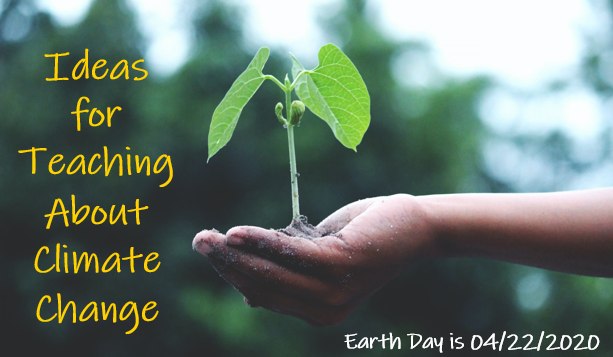
You may have seen media stories of the air being clearer since stay-at-home directives have been implemented in different areas of the world (Los Angeles, India). NASA satellite data actually shows a 30-percent decrease in air pollution over the northeast United States (click on the link to view slider image: Drop in Air Pollution). What does this all mean for our climate? How are your children and/or students reacting to the changes? Do they realize there are changes at all? This may be an opportune time to include climate change into your instructional plan, especially with the focus of Earth Day 2020 being climate action. So how can you do it? Here are 7 ideas to try:
- Similar to a K-W-L (Know-Want to Know-Learned) chart, set up a simple slide presentation and add responses and questions in real time. Start with a question, “What do you think climate change means?” Add responses to a new slide (include the date for later comparison). Then ask, “What do you want to know about climate change?” If needed, use the think-aloud method to add to the “W” slide (I want to know what it means. I want to know why the climate needs to change.). Revisit the presentation after new discoveries or lessons. The entire presentation can be viewed and meaningful comparisons made from what was known at the beginning to what has been learned at the end.
- Make connections to personal experiences, such as how stay-at-home directives has impacted the local area. Possibly compare weather patterns from the previous year to today. Although a definitive comparison can’t yet be made until daily activities “go back to normal”, it might be worth it to ask, “Are the stay-at-home orders making an impact on the climate?” The resulting discussion may start with ideas about immediate changes (less pollution, more animals seen in usually high-traffic areas) and connect to what this may mean in the long-term.
- Do an investigation that will engage students in the learning as well as improve critical-thinking skills, at any age. Do an online search for simple labs like simulations of the greenhouse effect using materials at home. There are also easy-to-use “portable labs” that support this type of inquiry-based learning, such as the Labdisc portable STEM lab. Besides the portable lab itself, this STEM-based tool includes climate-related lessons available for use like “Greenhouse Effect,” “Weather and Climate,” and “Coping with a Warm Environment.”
- Watch an age-appropriate movie that explores this climate change. A movie can be a great introduction to boost interest and set up a foundation for future learning. Or a movie can be used over the course of lessons to compare what has been learned and revisit the KWL. Click here for a list of age appropriate movie suggestions: Movies That Teach About Climate Change.
- Make time to read books about climate change. Reading can range from a simple read aloud and minimal discussion, to a weekly book-club style discussion. Create short quizzes to assess what they are understanding not only about the book being read, but about the topic of climate change. Do a quick search online for books specific to the ages/grades you’re working with. Start with this list: Children’s books about climate change.
- Encourage students to make personal goals on how to affect climate change positively. Fairly simple, short-term goals can include using less water and electricity. Challenge them to come up with goals that can affect the community or the area they live in, like organizing groups to starting a community garden or planting a tree a week at local parks.
- Have students complete a project that can be presented in a variety of ways: a slide presentation, short video, infographic, speech, etc. Encourage creativity but remind them that factual information needs to be used, including citations and references.
Speaking of factual information, use data from widely-recognized and trusted organizations such as the International Panel on Climate Change (IPCC), National Oceanic and Atmospheric Administration (NOAA), and NASA. You can also explore local resources on climate change education. For example the Washington State’s Department of Ecology has a section on climate change which includes data on greenhouse data. The Georgia Initiative for Climate and Society is a group from the University of Georgia that shares research on how the state will be affected by climate change. Use keywords such as ‘climate change’, ‘resources’, ‘education’, and the name of your city and/or state to start of your search.
Of course, developing lessons on climate change via distance learning may be a challenge. There are simple teacher-friendly tools available to help you navigate this relatively new teaching method such as G Suite for Education, which includes Google Classroom, and Office 365 for Education. Both include ways to create collaborative lessons as well as share lessons with school teams. Boxlight has created a series of webinars on Distance Learning using G Suite for Education and Office 365 for Education. For more information, click the link: Boxlight Together
So, does instruction focused on climate change stop after Earth Day? Of course not. Realizing that actions we take in our daily lives can affect the earth is worth investigating every day. So, why not start now?
Resources to consider when planning your lessons:
Global Climate Change: Lesson Plans for Educators
Global Climate Change Modules from PBS and NASA
MPR News: Climate change resources for kids learning at home


